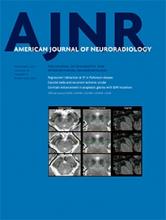Index by author
Dai, J.P.
- ADULT BRAINOpen AccessPatterns of Tumor Contrast Enhancement Predict the Prognosis of Anaplastic Gliomas with IDH1 MutationY.Y. Wang, K. Wang, S.W. Li, J.F. Wang, J. Ma, T. Jiang and J.P. DaiAmerican Journal of Neuroradiology November 2015, 36 (11) 2023-2029; DOI: https://doi.org/10.3174/ajnr.A4407
Daniere, F.
- NeurointerventionYou have accessLEO Baby Stent Use following Balloon-Assisted Coiling: Single- and Dual-Stent Technique—Immediate and Midterm Results of 29 Consecutive PatientsP. Machi, V. Costalat, K. Lobotesis, C. Ruiz, Y.B. Cheikh, O. Eker, G. Gascou, F. Danière, C. Riquelme and A. BonaféAmerican Journal of Neuroradiology November 2015, 36 (11) 2096-2103; DOI: https://doi.org/10.3174/ajnr.A4413
Davagnanam, I.
- Pediatric NeuroimagingYou have accessProspective Hemorrhage Rates of Cerebral Cavernous Malformations in Children and Adolescents Based on MRI AppearanceO. Nikoubashman, F. Di Rocco, I. Davagnanam, K. Mankad, M. Zerah and M. WiesmannAmerican Journal of Neuroradiology November 2015, 36 (11) 2177-2183; DOI: https://doi.org/10.3174/ajnr.A4427
Davitz, M.S.
- ADULT BRAINOpen AccessWhole-Brain N-Acetylaspartate Concentration Is Preserved during Mild Hypercapnia ChallengeS. Chawla, Y. Ge, H. Lu, O. Marshall, M.S. Davitz, G. Fatterpekar, B.J. Soher and O. GonenAmerican Journal of Neuroradiology November 2015, 36 (11) 2055-2061; DOI: https://doi.org/10.3174/ajnr.A4424
De Bree, R.
- Head and Neck ImagingYou have accessFusion of Freehand SPECT and Ultrasound to Perform Ultrasound-Guided Fine-Needle Aspiration Cytology of Sentinel Nodes in Head and Neck CancerR. de Bree, B. Pouw, D.A. Heuveling and J.A. CastelijnsAmerican Journal of Neuroradiology November 2015, 36 (11) 2153-2158; DOI: https://doi.org/10.3174/ajnr.A4426
Delone, D.R.
- FELLOWS' JOURNAL CLUBSpine Imaging and Spine Image-Guided InterventionsYou have accessCT Metal Artifact Reduction in the Spine: Can an Iterative Reconstruction Technique Improve Visualization?A.L. Kotsenas, G.J. Michalak, D.R. DeLone, F.E. Diehn, K. Grant, A.F. Halaweish, A. Krauss, R. Raupach, B. Schmidt, C.H. McCollough and J.G. FletcherAmerican Journal of Neuroradiology November 2015, 36 (11) 2184-2190; DOI: https://doi.org/10.3174/ajnr.A4416
CT images were reconstructed by using weighted filtered back-projection and iterative metal artifact reduction. Two neuroradiologists evaluated images in the region of spinal hardware and assigned a score for the visualization of critical anatomic structures by using soft-tissue and bone windows. Using bone windows, they measured the length of the most pronounced linear artifacts. Visualization of critical soft-tissue anatomic structures was significantly improved by using iterative metal artifact reduction, but there was not a significant improvement in visualization of critical osseous structures. Routine generation of these iterative reconstructed images in addition to routine weighted filtered back-projection is recommended.
Demchuk, A.M.
- FELLOWS' JOURNAL CLUBEXTRACRANIAL VASCULARYou have accessCarotid Webs and Recurrent Ischemic Strokes in the Era of CT AngiographyP.M.C. Choi, D. Singh, A. Trivedi, E. Qazi, D. George, J. Wong, A.M. Demchuk, M. Goyal, M.D. Hill and B.K. MenonAmerican Journal of Neuroradiology November 2015, 36 (11) 2134-2139; DOI: https://doi.org/10.3174/ajnr.A4431
Carotid web was defined on CTA as a thin intraluminal filling defect along the posterior wall of the carotid bulb just beyond the carotid bifurcation on oblique sagittal section CTA that was seen as a septum on axial CTA. In the prospective series in this study, the mean age was 50 years, and 5 of 7 patients were women. Recurrent stroke was seen in 5 of 7. Histopathology suggested a high probability of fibromuscular dysplasia. In the retrospective series, carotid webs were seen in 7 of 576 patients. Carotid web may be an important cause of ischemic stroke in patients with otherwise no determined mechanism of stroke and may present a high risk of recurrent stroke.
- NeurointerventionOpen AccessOutcome Differences between Intra-Arterial Iso- and Low-Osmolality Iodinated Radiographic Contrast Media in the Interventional Management of Stroke III TrialT.A. Tomsick, L.D. Foster, D.S. Liebeskind, M.D. Hill, J. Carrozella, M. Goyal, R. von Kummer, A.M. Demchuk, I. Dzialowski, V. Puetz, T. Jovin, H. Morales, Y.Y. Palesch, J. Broderick, P. Khatri, S.D. Yeatts and for the IMS III InvestigatorsAmerican Journal of Neuroradiology November 2015, 36 (11) 2074-2081; DOI: https://doi.org/10.3174/ajnr.A4421
De Rotte, A.A.J.
- EXTRACRANIAL VASCULARYou have accessIntraplaque Hemorrhage and the Plaque Surface in Carotid Atherosclerosis: The Plaque At RISK Study (PARISK)A.C. van Dijk, M.T.B. Truijman, B. Hussain, T. Zadi, G. Saiedie, A.A.J. de Rotte, M.I. Liem, A.F.W. van der Steen, M.J.A.P. Daemen, P.J. Koudstaal, P.J. Nederkoorn, J. Hendrikse, M.E. Kooi and A. van der LugtAmerican Journal of Neuroradiology November 2015, 36 (11) 2127-2133; DOI: https://doi.org/10.3174/ajnr.A4414
Desai, A.A.
- EDITOR'S CHOICEFUNCTIONALOpen AccessThe Contribution of Common Surgically Implanted Hardware to Functional MR Imaging ArtifactsA.A. Desai, M.K. Strother, C.C. Faraco, V.L. Morgan, T.R. Ladner, L.M. Dethrage, L.C. Jordan and M.J. DonahueAmerican Journal of Neuroradiology November 2015, 36 (11) 2068-2073; DOI: https://doi.org/10.3174/ajnr.A4419
The authors calculated the BOLD-dependent MR imaging artifact impact arising from surgically implanted hardware through a retrospective analysis of fMRIs acquired from 2006–2014. Mean artifact volume associated with intracranial hardware was 4.3 cubic centimeters. The mean artifact volume from extracranial hardware in patients with cerebrovascular disease was 28.4 cubic centimeters. Artifacts had no-to-mild effects on clinical interpretability in all patients with intracranial implants. Extracranial hardware artifacts had no-to-moderate impact on clinical interpretability. The exceptions to interpretability in the face of hardware were ventriculoperitoneal shunts, particularly those with programmable valves and siphon gauges, and large numbers of KLS-Martin maxDrive screws.
Desai, M.B.
- ADULT BRAINOpen AccessCurrent Applications of MRI-Guided Laser Interstitial Thermal Therapy in the Treatment of Brain Neoplasms and Epilepsy: A Radiologic and Neurosurgical OverviewR. Medvid, A. Ruiz, R.J. Komotar, J.R. Jagid, M.E. Ivan, R.M. Quencer and M.B. DesaiAmerican Journal of Neuroradiology November 2015, 36 (11) 1998-2006; DOI: https://doi.org/10.3174/ajnr.A4362








